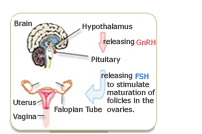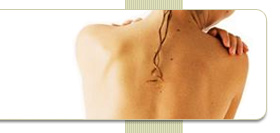34 MENOPAUSE SYMPTOMS |
HEALTH CENTER |
|
| |
|
|
|
|
|
|
Risk Factors for Osteoporosis |
|
|
|
|
|
|
Women who have a history of poor diet and inactivity before they reach menopause will be at an even greater risk for developing osteoporosis. Keep reading to learn about other risk factors for osteoporosis. |
|
|
Women continue to build bone until around the age of 35. The amount of bone you have by 35 is called your peak bone mass. If you have a lower bone density than normal by this age, you will be at a greater risk for osteoporosis later. If some of the following criteria apply to you, you may be at risk for low bone density and osteoporosis. |
|
|
- Family history of osteoporosis
- Diet inadequate in calcium, vitamin D
- History of eating disorders (anorexia, bulimia)
- Being underweight
- Smoking
- Amenorrhea, or cessation of menstrual periods (not due to menopause)
- Undergoing early and/or surgical menopause
- Sedentary lifestyle (spending less than 4 hours a day on your feet)
- High consumption of caffeine
- Ingestion of certain medications (corticosteroids, anticonvulsants)
|
|
Women do not have to take osteoporosis for granted. The key to effectively fighting osteoporosis is prevention, and inhibiting increased bone loss during menopause. Click on the following link to learn about the best solutions for preventing osteoporosis.  |
|
| |
|

|
|
Exercise helps prevent osteoporosis |
|
A recent article has shown that moderate and weight-bearing exercise can increase bone density and decrease the risk of osteoporosis even in postmenopausal women. However, overly intense aerobic exercise can have the opposite affect. |
|
|
| |
| |
| |
|
|
|
Osteoporosis may seem unstoppable, but there are different treatment options that can prevent the disease. Keep reading the section below to learn about the most effective treatments for preventing osteoporosis, including lifestyle changes, alternative treatments, and medical procedures.
|
|
|
|
|
|
Treatment for Osteoporosis
with
MacaActive Supplements |
|
As you have already read, osteoporosis are mainly caused by declining estrogen levels, which is a natural part of aging. Therefore, if you want relief from this undesirable symptom, you must restore estrogen hormone levels.
Today there are three effective ways to normalize hormonal levels: lifestyle changes, alternative medicine and drugs & surgery.
|
|
|
 |
Lifestyle Changes: This level of treatment involves no risk, but may be the hardest way to go because you'll have to restrict yourself from many things. That's why most people consider the next level of treatment, alternative medicine, which has proven to be excellent for treating osteoporosis in a safe and natural way.
|
|
|
 |
Alternative medicine: There are two types of herbal supplements for treating osteoporosis: Those containing phytoestrogenic herbs, and those containing non-estrogenic herbs. Phytoestrogenic herbs (like Black Cohosh) are filled with phytoestrogens, which are similar to estrogens. They can increase low estrogen levels by replacing some of the missing estrogen hormones. This isn't the best solution, however, because your body will become less responsive to producing estrogen on its own, causing a further decrease in body-own hormone levels. Unlike phytoestrogenic herbs, non-estrogenic herbs don't contain estrogen, but nourish hormonal glands to work more efficiently. This ultimately results in balancing not only estrogen, but other necessary hormones, as well. Non-estrogenic herbs are thus one of the best and safest ways to treat osteoporosis naturally.
An excellent example of a safe and effective non-estrogenic herb for hormonal imbalance is herbal MacaActive. What makes MacaActive so special is its ability to balance hormonal levels in women by nourishing the hormonal glands. It thus alleviates most disorders related to hormonal imbalance, including osteoporosis.  to read more about MacaActive.
|
|
|
 |
Drugs and Surgery: This level of treatment has the highest risk and often the highest costs. The most common drug therapy for treating osteoporosis in the US is hormone replacement therapy (HRT). There's no doubt that this is the quickest and strongest way to combat hormonal imbalance. Unfortunately, it entails serious side effects and increases the risk of different types of cancer in women. If you still want to consider this approach, see your doctor to become better informed about what this treatment option involves.
|
|
|
A safe way to balance hormones:
Non-estrogenic herbs are the most effective solution for treating hormonal imbalance and its related symptom, osteoporosis.
MacaActive is an excellent non-estrogenic herb. It's simple: rather than putting hormones from the outside into your body artificially, MacaActive stimulates your hormone glands into producing the necessary hormones naturally. This is what makes MacaActive supplements so unique.  to read all about MacaActive. |
 |
|
|
 |
|
|
|







